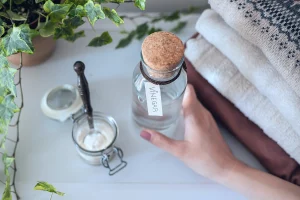
If you are into green cleaning, you probably already know that vinegar is one of the best, most powerful solutions that can be used for a number of things around the house. The reason why it is so great is the fact that it is very affordable, can be easily found pretty much anywhere, and is extremely powerful when it comes to deodorising, disinfection, and even stain removal.
Another fantastic use for vinegar is in the laundry. Keep reading to find out what benefits it has that will help you achieve excellent results every time.
Vinegar will help you get rid of musty smells
Leaving a load of wet items or towels in the washing machine can promote mildew growth and a rotten musty odour. If you forgot about yesterday’s load and realised it has already become smelly, grab the vinegar from the kitchen and try this method. Run a second full cycle with detergent added. Add 2 cups of white distilled vinegar to your washing machine and run a complete cycle at a hot temperature.
This works nicely for minor levels of mould and unpleasant odours. You’ll need to employ a more severe treatment for larger mould infestations and stains.
Brighter colours for your clothes
Distilled white vinegar contains acetic acid, which is so mild that it will not affect washable clothes. Nonetheless, it is strong enough to dissolve residues (alkalies) left by soap and detergent components. Adding just 1/2 cup of vinegar to the last rinse can result in brighter, clearer colours. Add the distilled white vinegar to the fabric softener dispenser, or add the vinegar manually at the beginning of the rinse cycle.
The mild acetic acid in vinegar also acts as a whitener and brightener for grey, dingy clothes. To get stained white socks and dingy washcloths white again, add 1 cup of white distilled vinegar to a large pot of water. Heat to boiling, and add the dingy items. Allow them to soak overnight, and then launder as usual. This method should only be used on 100% cotton fabric.
Vinegar will soften your clothes
This fantastic product is not only perfect for cleaning but will also soften your garments. If you no longer want to use commercial softeners that contain a lot of chemicals and artificial scents, try this hack. Simply add 1/2 cup to the last rinse cycle. If you prefer a faint aroma, add a couple of drops of lavender essential oil to the bottle of vinegar.
Pet hair and lint removal
Just 1/2 cup of white distilled vinegar in the rinse cycle will help prevent lint and pet hair from adhering to garments.
It also aids in the removal of excess lint if you mistakenly washed anything dark with lint-producing towels.
Get rid of bad underarm odours
Fill a spray bottle halfway with undiluted distilled white vinegar and store it in the laundry room to remove perspiration odours and stains from washable garments. Allow the vinegar to work for at least 10 minutes on the cloth on the inside of the underarm areas before tossing the garment into the washing machine. If the fabric is stiff before washing, break up the residue with a soft-bristle brush. The vinegar will help to cut through residual deodorant left on clothing and prevent underarm discolouration.
Say goodbye to hemlines
Moisten a white cloth with distilled white vinegar, place it under the fabric, and press to remove the tiny holes left along a seam or hemline when a garment is adjusted. To avoid scorching, use the proper ironing temperature and a pressing cloth on top of the fabric.
Get rid of cigarette and smoke odours
Cleaning your house and washing your clothes will not always manage to get rid of all the smoke odours that got stuck to your fabrics. If your washable clothes reek of cigarette or cigar smoke odour, add 1/2 cup distilled white vinegar during the wash cycle. Fill the bathtub with very hot water and 1 cup vinegar for dry-clean-only garments and furniture such as pillows and draperies. Close the door and hang the garments or fabric over the heating water so the steam may permeate the fibres.
Clean your washing machine
A clean washer equals cleaner laundry. Soap scum and mineral deposits can accumulate in your washer’s hoses, reducing water flow and performance. Four times per year, remove soap scum and clean the hoses by performing a complete wash cycle with the washer empty using hot water and 2 cups of distilled white vinegar.
Place distilled white vinegar in automated detergent or fabric softener dispensers to dissolve any residue buildup that may be limiting effectiveness.
Vinegar will help with the cleaning of your iron
Mineral deposits can clog the steam vents and spray nozzles of an iron. Fill the water chamber of the iron with a solution of equal parts distilled white vinegar and distilled water to clean it and remove the deposits. Place the iron upright on a heatproof surface and steam it for about five minutes.Rinse the tank with distilled water once the iron has cooled. Refill the iron and shake water through the vents onto an old rag. Finally, before ironing garments, iron an old cloth for several minutes to remove any residue.